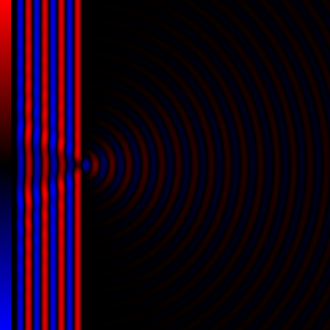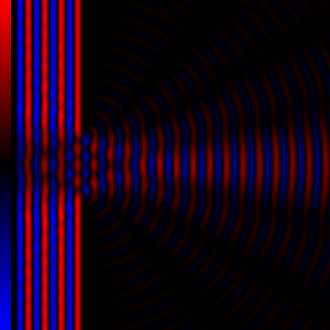f/16 Isn't Equal to f/16
Nov 24, 2018 10:36:34 #
Well, actually it is, or is it?
Let's get our brains working this morning with this poser. I've seen a number of comments on this site regarding using small f-stops and diffraction. The typical, don't use small apertures because that causes diffraction. So, what is diffraction? Diffraction of light occurs when a light wave passes by a corner or through an opening or slit that is physically the approximate size of, or even smaller than that light's wavelength. I've added the bold to emphasize the size required. So how big are those sizes?
Visible light has a range of wavelengths of 400 - 700 nanometers. Whoa, how big is a nanometer? It's .000000001 meters or .000000039370 inches. So 400 - 700 nanometers is .0000004 - .0000007 meters or .000015748 - .000027559 inches. These dimensions are quite a bit smaller than any apertures we're using with our cameras.
So getting back to our original statement, f/16 is actually equal to f/16. But, that's because f-stops are ratios. What isn't the same is the diameter of the aperture from one lens focal length to another. For example, let's take two lenses, In this case, we'll examine two Schneider-Kreuznach lenses of focal lengths 150mm and 210mm. At f/16 the aperture opening is:
150 - 9.375mm
210 - 13.125mm
Obviously, a large difference in aperture diameters, but the same f-stop. However, neither is close to the wavelength range of visible light.
Since diffraction occurs as stated above, neither of these measurements are close to the dimensions required to meet the above conditions. So, how would light know which lens it's passing through? Oh, and if you want to make an issue of the "passing by a corner", well, that corner exists at every f-stop, other than perhaps the greatest opening.
The conclusion of this could be that we're parroting some misinformation, making a blanket statement that doesn't cover all situations, or we may be concerning ourselves needlessly. If diffraction does occur, is it observable in our photographs?
--Bob
Let's get our brains working this morning with this poser. I've seen a number of comments on this site regarding using small f-stops and diffraction. The typical, don't use small apertures because that causes diffraction. So, what is diffraction? Diffraction of light occurs when a light wave passes by a corner or through an opening or slit that is physically the approximate size of, or even smaller than that light's wavelength. I've added the bold to emphasize the size required. So how big are those sizes?
Visible light has a range of wavelengths of 400 - 700 nanometers. Whoa, how big is a nanometer? It's .000000001 meters or .000000039370 inches. So 400 - 700 nanometers is .0000004 - .0000007 meters or .000015748 - .000027559 inches. These dimensions are quite a bit smaller than any apertures we're using with our cameras.
So getting back to our original statement, f/16 is actually equal to f/16. But, that's because f-stops are ratios. What isn't the same is the diameter of the aperture from one lens focal length to another. For example, let's take two lenses, In this case, we'll examine two Schneider-Kreuznach lenses of focal lengths 150mm and 210mm. At f/16 the aperture opening is:
150 - 9.375mm
210 - 13.125mm
Obviously, a large difference in aperture diameters, but the same f-stop. However, neither is close to the wavelength range of visible light.
Since diffraction occurs as stated above, neither of these measurements are close to the dimensions required to meet the above conditions. So, how would light know which lens it's passing through? Oh, and if you want to make an issue of the "passing by a corner", well, that corner exists at every f-stop, other than perhaps the greatest opening.
The conclusion of this could be that we're parroting some misinformation, making a blanket statement that doesn't cover all situations, or we may be concerning ourselves needlessly. If diffraction does occur, is it observable in our photographs?
--Bob
Nov 24, 2018 10:41:14 #
Nov 24, 2018 11:13:34 #
rmalarz wrote:
Well, actually it is, or is it? br br Let's get o... (show quote)
Your explanation is patently false. "the approximate size of, or even smaller than that light's wavelength" is pure fantasy as the attached gif's show. The first gif shows diffraction of a scalar wave passing through a 1-wavelength-wide slit, while the second gif shows diffraction of a scalar wave passing through a 4-wavelength-wide slit, thus diffraction does NOT require an opening "the approximate size or even smaller than the wavelength", as four wavelengths is not considered the approximate size in wavelengths in any coherent thought system.
A slit which is wider than a wavelength produces interference effects in the space downstream of the slit. These can be explained by assuming that the slit behaves as though it has a large number of point sources spaced evenly across the width of the slit. The analysis of this system is simplified if we consider light of a single wavelength. If the incident light is coherent, these sources all have the same phase. Light incident at a given point in the space downstream of the slit is made up of contributions from each of these point sources and if the relative phases of these contributions vary by 2π or more, we may expect to find minima and maxima in the diffracted light. Such phase differences are caused by differences in the path lengths over which contributing rays reach the point from the slit.
You are 100% correct about "parroting some misinformation" however.


Nov 24, 2018 11:13:34 #
"The conclusion of this could be that we're parroting some misinformation, making a blanket statement that doesn't cover all situations, or we may be concerning ourselves needlessly."
The question as posed is far to simple to have a simple answer. What is the sensor size on the camera in question? How good is the anti-aliasing filter in the camera in question?
If you want a short answer I would say this. For most modern DLSR's, at f/16 the answer is that diffraction probably plays a minor role, if any at all.
For a more complete answer, go here. https://www.cambridgeincolour.com/tutorials/diffraction-photography.htm
The question as posed is far to simple to have a simple answer. What is the sensor size on the camera in question? How good is the anti-aliasing filter in the camera in question?
If you want a short answer I would say this. For most modern DLSR's, at f/16 the answer is that diffraction probably plays a minor role, if any at all.
For a more complete answer, go here. https://www.cambridgeincolour.com/tutorials/diffraction-photography.htm
Nov 24, 2018 11:20:33 #
If you want to argue with the physicists making these statements, go right ahead. I didn't make the statement regarding slits the size of or smaller than the wavelength. That was quoted from a source on physics and light. So, it's not my explanation, but the basis of presenting the argument that we may be forwarding information that is not applicable to what we are photographing.
--Bob
--Bob
kd7eir wrote:
Your explanation is patently false. " b the a... (show quote)
Nov 24, 2018 11:21:58 #
"...is that diffraction probably plays a minor role," exactly my point.
--Bob
--Bob
jeweler53 wrote:
"The conclusion of this could be that we're p... (show quote)
Nov 24, 2018 11:22:03 #
Nov 24, 2018 11:25:22 #
Exactly my point.
--Bob
--Bob
jerryc41 wrote:
Nov 24, 2018 11:41:57 #
For me the bottom line is: This is strictly academic. You don't need to understand any of this to make great images. Did any of the old masters understand this...doubt it.
Nov 24, 2018 11:43:26 #
The Index of Refraction is wavelength dependent (consult any college textbook on optics or physics with an optics chapter), so light passing an edge refracts variably. Note the red sunsetting sun. Aperture diffraction would seem to become more noticeable at small apertures (high f stops) because the edge zone makes up a larger fraction of the entire aperture area. Looking into the front with lens dismounted shows that all surfaces except for the sensor are dead black to zero out light reflections. Now the lens floods the entire camera interior and the edge refraction zone is at the outer edge area. If this area reaches the sensor, the sensor should record the diffraction rays. At what aperture should the duffraction edge zone touch the sensor. I have a hunch this deal has gotten beyond my pay grade, so I will quit before drowning in words.
Nov 24, 2018 11:46:18 #
rmalarz wrote:
...If diffraction does occur, is it observable in our photographs?
--Bob
--Bob
That's the practically important question in your post. The smart thing any camera owner should do is TEST the gear, as a system, to see how each range of settings and combination of lens/camera/accessory performs.
When I buy a camera and/or a lens, I test it under controlled conditions to be sure everything works together as advertised, and to record HOW WELL and HOW it works at every setting. I do this because I am a complete control freak when it comes to getting as much of what I want as I can — in the image, AT the camera. I love post-processing, but hate the time it takes. So I compromise.
When I bought my Lumix GH4, a Micro 4/3 camera, I knew diffraction with a small format 16MP sensor was a likely issue. I tested each of my lenses at every f/stop, and noted the results I saw at 100% magnification in Photoshop. All three of my lenses (12-35mm f/2.8, 30mm f/2.8 macro, 35-100mm f/2.8) tested *best* at f/4, great at f/2.8 (wide open), great at f/5.6, acceptable at f/8, soft at f/11, VERY soft at f/16, and downright fuzzy at f/22. This, and the fact that Micro 4/3 lenses are half the focal length of full frame lenses for a given field of view, forced me to buy ND 8 and ND 64 (three and six stop light reduction) filters.
Because of the increased depth of field at shorter focal lengths, I don't NEED apertures smaller than f/8 in 95% of situations. And because I record lots of film-style video at 24fps, I'm using 1/50 second shutter speed (and occasionally 1/25). So ND lets me work in all sorts of conditions, use the best apertures on the lens, live with ISO 200 as the lowest (native) ISO, and keep DOF reasonably shallow.
It's this sort of practical yet analytical testing that educates us about our gear in ways that allow us to exploit the best of it in the field. All the formulas in the world are meaningless until you test the gear.
When I was at the school portrait company, I trained photographers to set up their portrait lighting. I learned, early on, not to trust that a given light with a given modifier at a given distance and power pack setting would yield the same exposure as another light of the same exact type. It was necessary to meter every instrument! We could see differences of 1/3 stop in a school yearbook if two or three photographers worked in the same school. There were distances of over a stop between instruments, and many variables that affected the difference. So we tested, and STRUNG our lights for distance...
Nov 24, 2018 11:57:50 #
rmalarz wrote:
Well, actually it is, or is it? br br Let's get o... (show quote)
I don't concern myself with most of this needless BS. I use an f-stop that needs to be used. Like high ISO, an image with no movement and some noise is better to me than a blurry movement image with no noise.
So if corners can induce diffraction except at wide open where there are no corners, what is the effect on diffraction from a 6 bladed lens vs a 12 bladed lens. Does the cheap lens(the 6 bladed lens), produce more noticeable diffraction???
SS
Nov 24, 2018 12:30:25 #
rmalarz wrote:
Well, actually it is, or is it? br br Let's get o... (show quote)
Bob, these are two comprehensive explanations I've come across - and they address lots of myths - without creating any new ones - and they have lots of practical and theoretical examples to mull over as you consider eating yet another round of leftover turkey and deal with it's corresponding post-meal turkeycoma.
https://photographylife.com/what-is-diffraction-in-photography
https://backcountrygallery.com/lens-diffraction-in-photography/
Nov 24, 2018 12:31:43 #
rmalarz wrote:
...Diffraction of light occurs when a light wave passes by a corner or through an opening or slit that is physically the approximate size of, or even smaller than that light's wavelength...
First off, I would substitute the word "edge" for "corner". The word corner implies to me some sort of angle. And diffraction can occur from a straight edge.
Second, I would note that the dimensions of the opening or slit do not have to be the approximate dimension of a wavelength or smaller. Diffraction can occur at a single edge with a very large space on either side.
But the important thing here is the effect on photographs.
Diffraction will occur at all f/stops, for any lens. The key is whether or not the diffraction will impact the sharpness of the image when compared to the pixel size. Large apertures generate small diffraction pattern dimensions so they can be considered negligible. The dimensions of the diffraction pattern will increase as the aperture is decreased. At some point the dimensions of the diffraction pattern becomes similar to the pixel size. That's where diffraction can become important in your photographs. High pixel count cameras will be more sensitive to diffraction effects than low pixel count cameras because the individual pixels are smaller, so the diffraction pattern will become important at smaller dimensions, or larger apertures.
Practically, f/11 has been used by a lot of people as the onset of the importance of diffraction. As cameras go to higher pixel counts the importance of diffraction will increase, leading to larger apertures where diffraction effects start to occur.
Nov 24, 2018 13:01:16 #
I have found this link to be helpful in understanding the mechanism, but I agree with Bill - testing/knowing your own equipment and its limitations is key. https://www.cambridgeincolour.com/tutorials/diffraction-photography.htm
If you want to reply, then register here. Registration is free and your account is created instantly, so you can post right away.


 I will stay tuned!
I will stay tuned!





